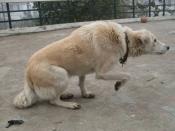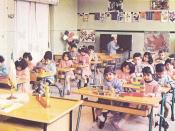The teacher walks around the playground contently watching the students get some physical exercise in between learning. She sees all the children are getting along nicely, playing on the swings, running around, and playing tag, until a young boy approaches two girls by the swings. The young boy verbally threatens the girls to leave so he could swing or else he would push them off. This is a case of relational and overt aggression and is a problem in our preschools today, which is why researchers are investigating to gain knowledge in this area to try to solve the problem. Relational and Overt Aggression is an important social issue as it is a factor in the detection of a child's difficulty in adjustment early in life.
The reason studies like this one are important is because they provide us with evidence that relationally aggressive behaviors are highly aversive and damaging to children in preschool.
(Crick, N. and Casas, J. Relational and Overt Aggression in Preschool, 1997) This evidence is important to have because it contributes to the study of the whole child and his/her early development. An understanding of these important early years in life and the impact different experiences have on a young child will also help us understand their behavior as they grow and develop. If researchers are able to detect difficulties in a child's social behavior, and they are able to provide some intervention during these years, it may prevent social adjustment problems such as excessive kicking and verbal threats in later years. Children in preschool programs spend much of their time learning to interact with their peers. The article shows that some of these interactions result in aggressive behaviors. It is important to look at these behaviors to determine causes as well as the impact it has on their development.
According to the article, the main goal of the study is to develop reliable measures of relational aggression for young children and to utilize these tools to address several important issues. (Crick and Casas) Issues such as solving acts of aggression and saving peer relationships. In other words, the study is trying to measure aggression in the behaviors of preschool children so they may determine the cause, the impact of the behavior, as well as intervention techniques to stop the behavior. Researchers want to gain knowledge in this area so they may address these social issues and solve a problem which is seen in preschool everyday. Once the researchers are able to identify the possible causes of relational aggression and identify a means to measure the aggression, they are better able to predict potential future aggressive behaviors and develop effective techniques to deal with such behavior.
This longitudinal study of aggressive children contains different approaches to accomplishing the results. The article mainly looks at measuring what teachers see and what peers see. When getting results from peers it is more valid than that from teachers because there are "multiple informants" (Crick and Casas) but at the same time they may not answer questions reliably. Teachers have greater access to the interaction between the children but there are fewer teachers than children making it less reliable. The best way to approach this problem is the Multi-informant approach where both teacher and peer reports of aggression were extracted to the degree to which these informants agreed and then evaluated. (Crick and Casas) Now the study becomes both reliable and valid as there are multiple informants and greater access to the interactions.
Overall, the results of the research showed that when aggression occurred, it was caused by relational or overt aggression 66% of the time. Using the results obtained from the teachers and peers it seemed that, most of the time, the children were non-aggressive, but aggressive behavior was demonstrated occasionally. According to teachers and peers boys were aggressive about 15% of the time while girls were aggressive about 5% of the time. These findings help researchers to gain more knowledge about the differences between boys' and girls' social behavior. They also learned ways to lower the percentage of aggressive acts in preschool children as they observed their habits and behavior with other children. The study was conducted in a valid and reliable manner using both peer and teacher reports. It analyzed the factors that play a role in aggressive behavior which is quite common in our preschools today.





